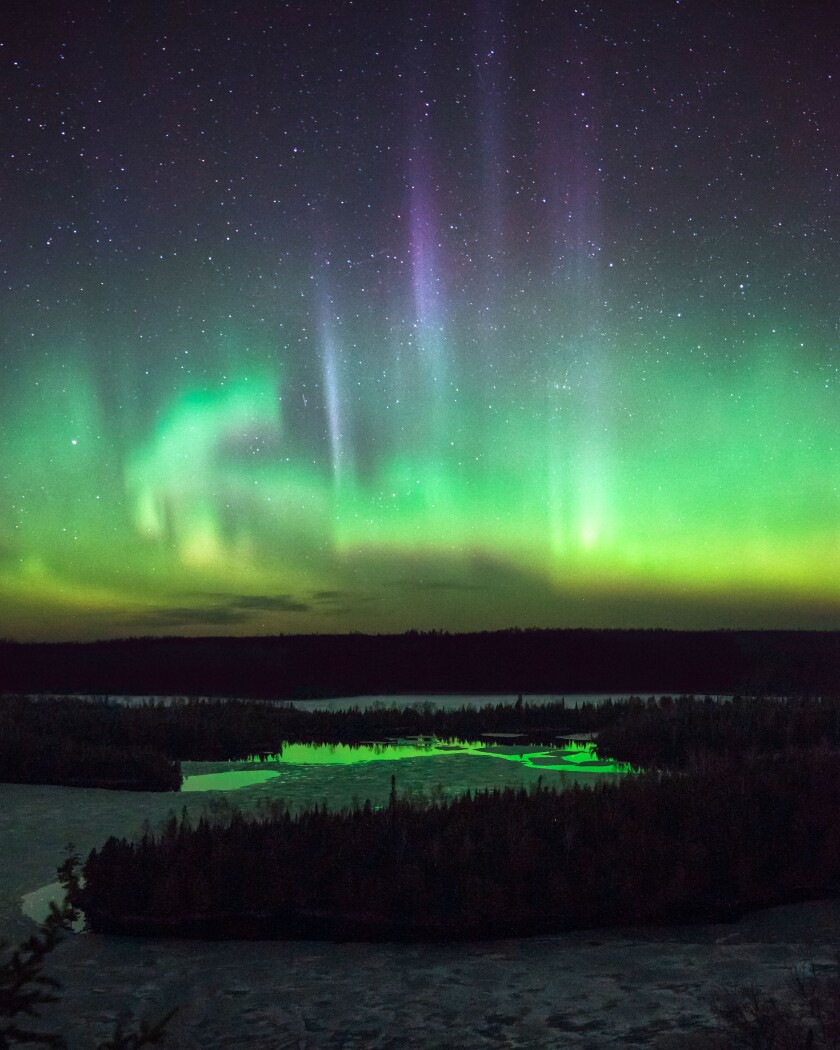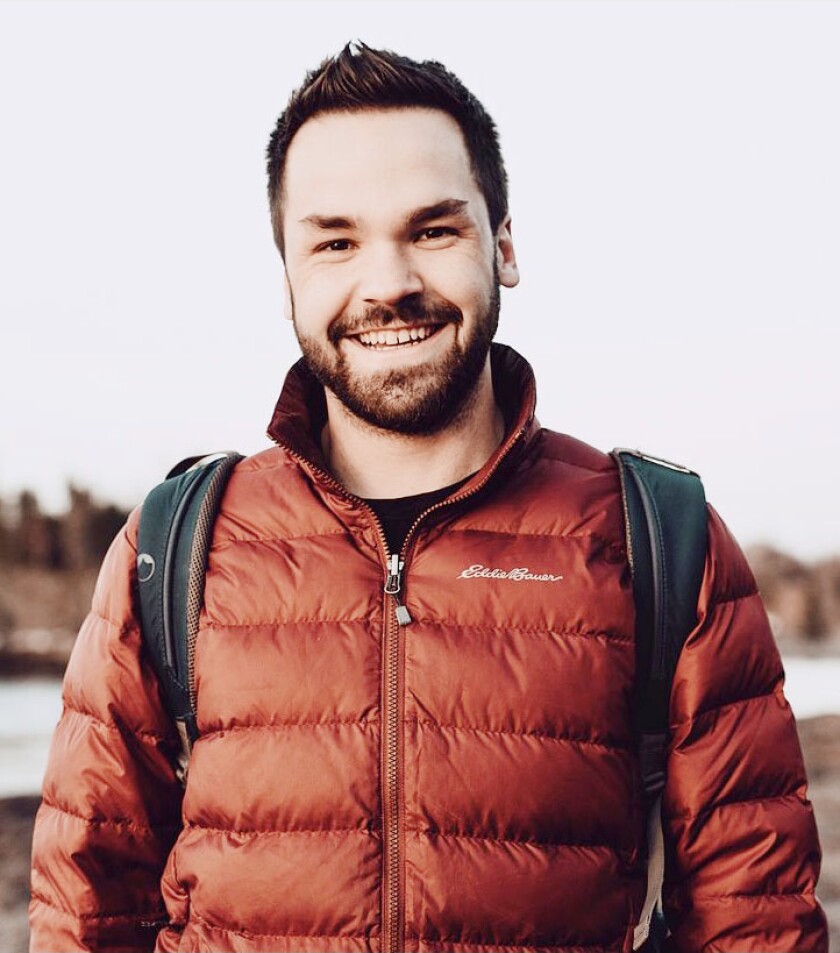Minnesota photographers give insight on capturing the northern lights
Jan 31, 2022 05:53AM ● By Editor
Aurora borealis, better known as the northern lights, are elusive with their night dances. Their rarity comes from the fact our eyes are not always capable of picking up their light, even in the darkest of nights.
Due to their shifty nature and our eye’s lack of ability to pick up their lights, most of the time, northern lights are best seen through a camera’s lens.
Tim Erickson of Alexandria crossed off a section of his bucket list by capturing the northern lights from his dock on Smith Lake. His shot was featured as a Photo of the Week in the Echo Press.
“I've always liked taking pictures, whether it be landscape, wildlife or any of those kinds of things,” he said. “It's the satisfaction that you were able to see something and capture it."
He said his biggest challenges were focusing the lens and finding the perfect settings, which gave him a greater appreciation of what it takes to capture them.
“It's like hunting for Bigfoot to some degree. You're just hoping to get a glimpse of something really cool,” said Erickson.
The first time George Ilstrup, a Duluth area photographer who graduated from Alexandria Area High School in 2014, saw the lights, he didn’t know what they were.
He and some college buddies from the University of Minnesota Duluth were driving north up the shore of Lake Superior in either the fall or spring to capture shots of stars when they noticed “weird little flashes in the night sky,” Ilstrup said. They were close to Split Rock Lighthouse by this time and decided to pull into the parking lot to get a better view.
“I remember seeing this beam right over split rock. It wasn’t extremely bright, but you could see it. It was pulsating,” he said. “We sprinted from the car for a better view.”
Ilstrup spent that night capturing the northern lights on camera for his first time, but it would not be his last. A few years later, he would see a light show that he described as a flame of colors waving in the sky.
“Your camera picks them up so much brighter than what your eyes actually see because a camera can pick up more light than we can,” said Ilstrup.
With the help of photographers like Ilstrup and Erickson, who hunt down these mysterious lights of the night, we can get a better picture of their beauty.

Ilstrup says those looking to capture a northern lights shot should adjust their expectations.
"The whole sky is not going to turn neon green. Most of the time, it is a very muted green off in the horizon,” he said.
He suggests going out as soon as it gets dark, as they can happen during the day can't be seen because of the sun.
"Many people get hung up on what time they should shoot. My answer is when the sun goes down. The rest is just a waiting game of trials and errors," he said.
Ilstrup says he plans his night of chasing lights by checking specific data points from the Space Weather Prediction Center / National Oceanic and Atmospheric Administration. Its website displays current CME readings — Coronal Mass Ejections — a significant release of plasma and accompanying magnetic field from the sun's corona into the solar wind.
“Basically, a solar flare that breaks off from the sun will travel a crazy distance to the earth,” said Ilstrup. “The goal is that the CME will hit the Earth’s atmosphere. You could get really good northern lights when that happens, but they are unpredictable. I think it takes an average of three days for them to reach the Earth, so you don’t really know when it will hit. It is a guessing game.”
There is also the KP index — the disturbance of the Earth's magnetic field caused by the solar wind. The faster the solar wind blows, the greater the turbulence, according to https://auroraforecast.is. Ilstrup says when he goes out, he likes the KP index to be over five.
He also checks for things like cloud cover and moon phases. If there are too many clouds, you won’t see the lights. Their glow will drown out the northern lights if the moon is too full.
“And you do not have to be far north to see them. If it is a strong light show, you will see them — even from the Alexandria area," Ilstrup said, adding that it helps to get away from the town’s light pollution.
"I suggest going at least five to 10 miles out of town.”

Ilstrup shoots with a Sony A7R4 equipped with his Sony 16mm - 35mm F4, Sony 24mm - 70mm F2.8, or his 12mm F2.8 lens. While Erickson shoots with a Nikon 5100 and a Tamron 18mm - 70mm lens.
Ilstrup suggests, for those starting to get into photography, not to buy the most expensive camera and lens. Buy what you can afford and practice, practice, practice like you would with any other skill. Get good with the camera you have and update as needed, he said.
“Figure out what camera is right for you or what you can afford. And don’t compare yourself to others, which is easy to do in today’s world with social media. You’re going to be really bad right away. Everyone is. It is just a matter of getting out and doing it and connecting with people.”

Ilstrup listed several key factors for shooting the northern lights:
Shutter speed — the speed at which the shutter of the camera closes. A fast shutter speed creates a shorter exposure — the amount of light the camera takes in — and a slow shutter speed gives the photographer a longer exposure.
Ilstrup says the trick is to get the perfect exposure time to capture the movement of the lights, usually around one to two seconds. Finding the sweet spot for shutter speed will produce a sharper image of the lights. Otherwise, the photo will end up looking like a “blob” of color.
“The longer the shutter speed, the more the lights are going to blur together because they are constantly moving,” said Ilstrup. “I’ll normally try to keep mine under five seconds, but it is a lot of trial and error.”
Aperture — the opening in a lens through which light passes to enter the camera. If you think of the aperture as the pupil of a camera's eye, you can shrink or enlarge the size of the aperture to allow more or less light to reach your camera sensor.
Ilstrup suggests keeping your camera’s aperture as wide open as you can. Ideally, with a lens with an F stop of 2.8 or lower.
“The lower the number gets, the better your pictures will be; the lower the aperture, the more light the camera will let in,” he said.
Since the northern lights are lights that our eyes can not always pick up, a wide aperture allows your camera to see what our eyes can't.
ISO — your camera’s sensitivity to light. It will brighten or darken a photo, which can help you capture images in darker environments. A lower ISO value means less sensitivity to light, while a higher ISO means more sensitivity.
“It depends on the camera,” said Ilstrup. “My camera does pretty well in the dark. I can set the ISO up to 10,000 and not worry about too much noise.”
He suggests raising the ISO anywhere from 3,200 to 10,000, depending on the camera’s capabilities.
Ilstrup says one of the trickiest parts of capturing the lights is getting your camera’s focus just right. He suggests getting out a little before dark and focusing on a spot that will show the lights in the background; a tree line is a good example. To help stay in focus, use a tripod and set a shutter timer to reduce shakiness from shooting by hand with a more extended exposure shot.
“And it needs to be in manual focus,” Ilstrup added. “I know some people that will put a piece of tape on their camera’s lens, so they know exactly where the right focus is.”

Erickson enjoys the challenge of playing with the camera's technology and being able to capture something unique.
"It's fun to be able to get good pictures," said Erickson. "My dad took lots of pictures and he loved it. I'm sure a lot of it came from watching him and the enjoyment he got from photography."
Ilstrup first started his venture into photography during his sophomore year at UMD. After years of beating up his knees snowboarding, he tore his ACL and needed a new hobby to keep him busy until he healed.
“My friend, Ian Deloney, taught me how to use a camera. He and I started going out with a crew of friends to do some hiking and mess around with our cameras and slowly started doing it more and more, then eventually all the time,” said Ilstrup. “Getting up early for sunrise pictures was a much more productive use of my time. It became addicting, but also a good positive hobby; better than drinking and going to house parties.”
With a buddy who was into photography, a camera he used for skate and snowboard videos and a love for the outdoors, landscape photography became Ilstrup's passion.
Today, Ilstrup has over 39,000 followers on Instagram with a website to order calendars and prints of his photos, featured in articles from multiple publications and a catalog of landscapes and nature shots from around the world.
His works feature shots of rolling Lake Superior waves — captured in the water with the help of a wetsuit and waterproof housing kit for his camera. He's also captured images of the autumn leaves of northwestern Minnesota, hidden waterfalls along the North Shore, vibrant sunrises, twisting tornadoes and lightning strikes, the roaring wildfires of Greenwood, European landscapes from his time abroad and of course, northern lights.

“I really enjoy everything outdoors-related,” said Ilstrup, who grew up on a decent size property outside of Hoffman where he and his family did a lot of outdoor activities. “Getting outside is fun; there is so much out there. I enjoy the challenge of getting out and trying to line up the perfect shot, even if that means going out for sunrise to the same spot, five times in a row.”
To see the original post and read related stories, follow this link to the Echo Press website. https://www.echopress.com/lifestyle/minnesota-photographers-give-insight-on-capturing-the-northern-l...

